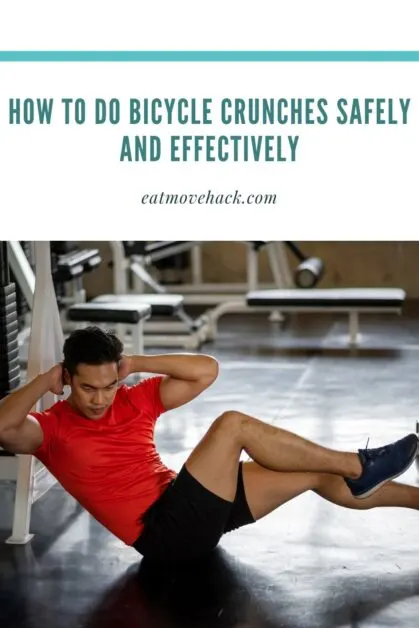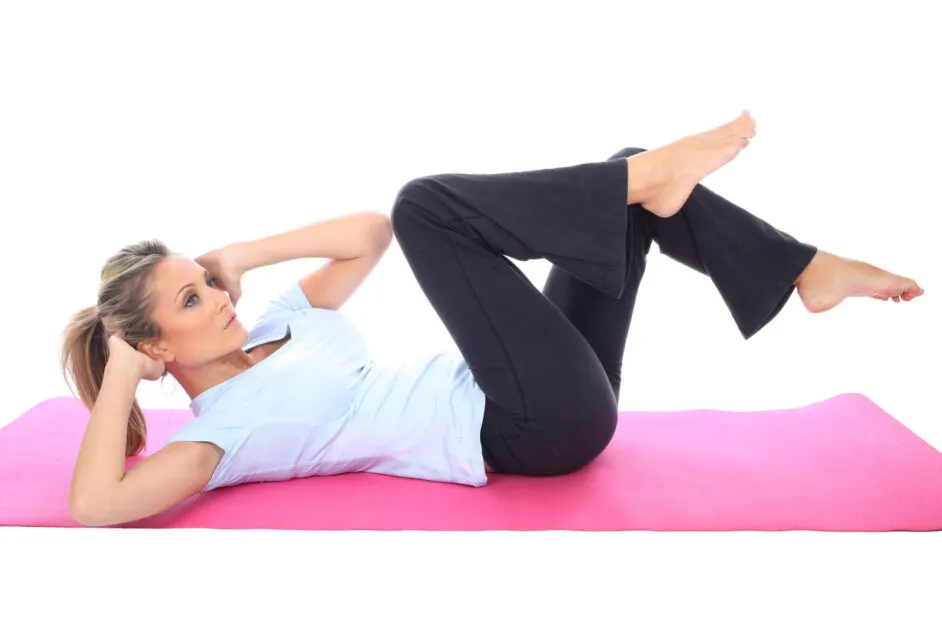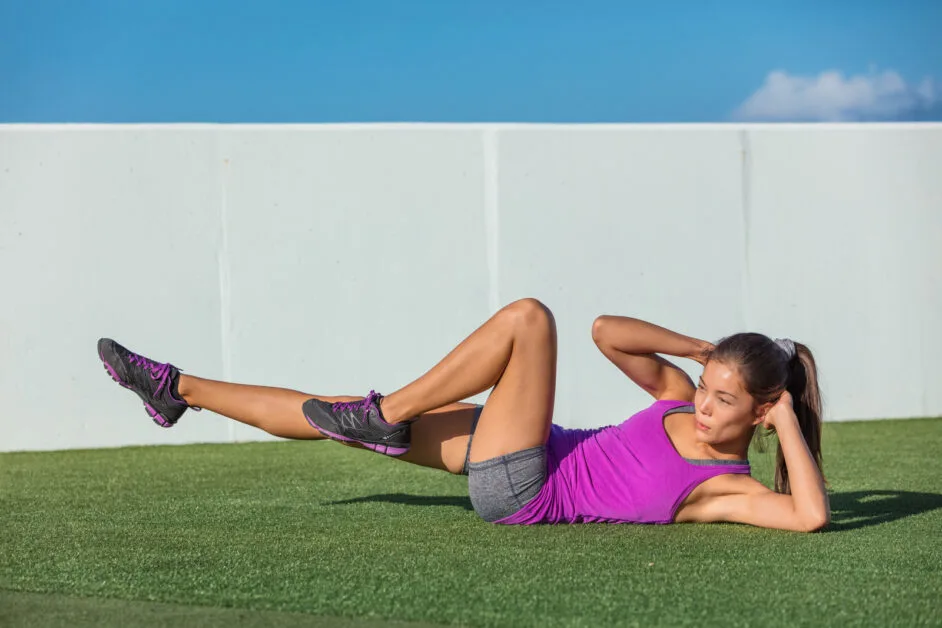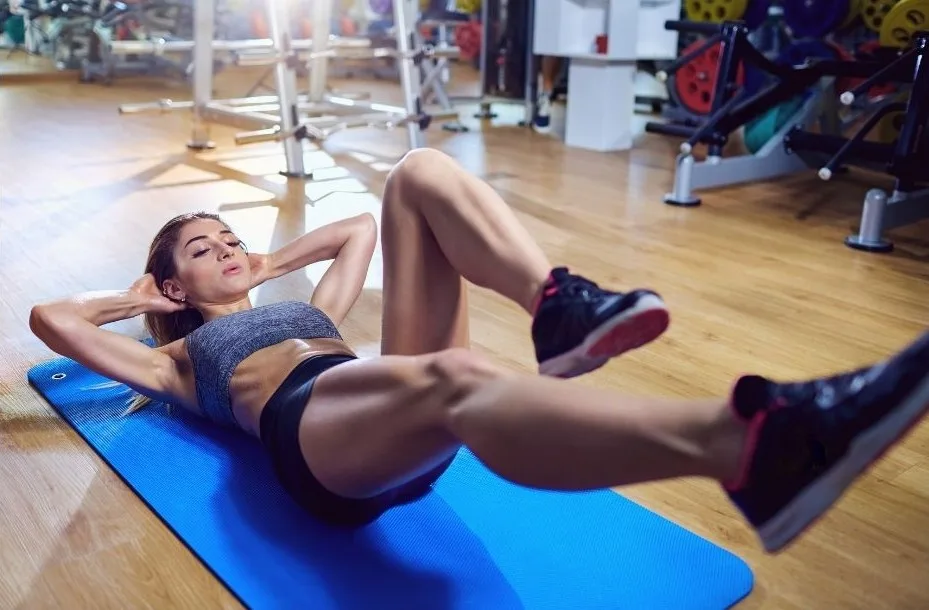Some of the links in this post are affiliate links. This means if you click on the link and purchase the item, we will receive an affiliate commission from the vendor at no extra cost to you. These business relationships allow us to keep bringing you great EatMoveHack content. All opinions remain our own.
At a Glance Info: Bicycle Crunch
Targets: rectus abdominus, internal and external obliques, transverse abdominus
Equipment Needed: None
Level: Beginner/Intermediate/Expert
Having a strong core and abdomen is essential to maintain our overall health and fitness. Regardless of age, gender or fitness goals, our core muscles work to support the body in our everyday life as well as during intense physical activity.
Developing a healthy and strong abdominal core isn’t easy, it requires taking time regularly to exercise and train the muscles in our upper abdomen, lower abdomen and lower back. However, the results are worth the effort. A strong results in good posture, greater stamina, less back pain and, for those really devoted to the cause, an enviable six-pack.
But, what exercises are best for developing a strong core? There are plenty to choose from, and usually, the best exercise for you is the one you like best and are willing to do regularly. However, according to the American Council On Exercise, when performed properly the bicycle crunch is the best exercise for increasing abdominal strength.

What is a Bicycle Crunch and What are The Benefits?

Bicycle crunches are a classic core strengthening exercise. When performed properly, they are an ideal exercise that people of all fitness levels can use to improve abdominal and lower back strength.
Favoured by fitness trainers, bicycle crunches target several muscles in the body’s core simultaneously without the need for specialized equipment. Simple and highly effective, bicycle crunches are simply a great exercise to build core strength. They can be performed anywhere and be customized to meet every fitness level.
Muscles worked when a bicycle crunch is performed include:
- Oblique muscles
- Upper abdominals
- Lower abdominals
Other muscles that benefit from this manoeuvre are the hamstrings, quadriceps and hips.
Benefits of the Bicycle Crunch
A bicycle crunch delivers multiple benefits to a person’s overall health and wellbeing. They are a strength-enhancing exercise which means they offer the same health benefits as other strengthening activities. Some of these benefits include:
- Improved core strength.
- Improved posture
- Less back and neck pain
- Increased energy
- Improved cardiovascular health
- Lowers the risk for bone-related diseases such as osteoporosis
How to Perform a Bicycle Crunch Safely
Performing a bicycle crunch properly is very important. It will help lower your risk of injury and allow you to get the most out of this challenging exercise. Before adding these exercises to your physical fitness plans, read the following step-by-step instructions.
Once you’re ready to try them out, ensure you’re body is warmed up and ready for vigorous activity. To warm-up, do 5 – 10 minutes of light aerobic exercise.
Step One – Lie Flat On the Floor
Start by lying down on a smooth surface. Use a yoga mat, towel or blanket if you find the floor too uncomfortable. Next, bend your knees while leaving your feet flat on the floor. Ensure your lower back is pressed into the ground while your knees are bent and elevated.
Step Two – Put Hands Behind Head
Once you’re lying down with your knees bent and feet planted on the floor, place your hands behind your head. Your hands are only there to support your head. DO NOT use your hands and arms to pull on your neck and propel yourself forward. If having your hands behind your head is too uncomfortable, place them on either side of your body.
Step Three – Tighten In Stomach Muscles
While exhaling, engage your core muscles and lift your upper chest towards your knees. As you do this, ensure your neck is comfortable and your lower back remains pressed into the ground.
Step Four – Engage Your Legs
With your abdomen engaged, lift your feet and raise your knees to a 90-degree angle. Your knees should be pointing towards your nose. Keep your feet flexed to help support your hamstrings while they work.
Step Five – Ride A Bike!
With your upper body and lower body engaged, begin to move your legs in a forward motion that mimics pedalling. To do this, bring one knee up towards your shoulder while extending the other leg. Switch legs. When you extend your legs, keep your feet off the floor. As you pedal, keep your upper body engaged and shoulders off the floor.
Tip: The lower your leg is when extending it away from you, the more challenging the exercise will be.
Step Six – Add A Twist

To engage the obliques, add a twist to your motion. To do this, rotate your torso towards the knee that is bent as you try to bring the opposite elbow towards that knee. Then, as you extend the bent leg away and bring the alternate knee inwards, twist your core to meet the other knee with the opposite elbow.
Step Seven – Repeat
Aim to do 3 sets of 15 bicycle crunches with a rest in between. If counting repetitions isn’t ideal for you, try to do as many as possible in three intervals of 30 – 60 seconds each.
Common Bicycle Crunch Mistakes
All forms of physical exercise come with some level of risk. This is no different for abdominal exercises such as a bicycle crunch.
As beneficial as a bicycle crunch can be, they must be executed correctly. if performed without proper form, these six-pack building exercises can be ineffective. Additionally, physical strain or muscle injury may also result when poor technique isn’t corrected.
When performing bicycle crunches, the 3 most common mistakes to avoid include:
Poor Neck Posture
With exercises that require your hands to rest behind your head, it’s easy for the upper body to bear the brunt of the activity. However, if your neck muscles engage, they can easily become pulled or strained.
Additionally, if your neck and shoulders are doing the heavy lifting, your core isn’t working as hard as it should. In order to develop a strong and lean core, you need those ab muscles to do the work, not your upper body.
To avoid straining your neck, don’t lift your head more than you can comfortably do so without engaging your neck. This may mean you aren’t able to reach your knees with your elbows at first, but that’s ok. Engaging your abdominal muscles to their limit is more important in core exercises than risking a pulled muscle.
Back Lifting Away From Floor
When performing core exercises from a laying down position, keep your lower back on the floor. To do this, imaging bringing your belly button to the floor below you and try keeping it there.
Every few breaths, check in with your spine and see if your back is still pressed down. If not, readjust your posture and guide your belly button downwards again.
Rotating Hips and Not Torso
Relying on your hips for momentum when switching sides takes away from the integrity of the exercise. In order for a bicycle crunch to be as effective as possible, abdominal muscles need to be engaged continuously. Keep your hips on the floor and use your torso muscles to rotate.

Variations for a Bicycle Ab Workout
Without variety, a bicycle ab workout can become dull and uninspiring. However, these exercises are so effective, we have some variations you can use to keep them in your core strengthening repertoire. From beginners to seasoned athletes, there’s a bicycle crunch exercise perfect for everyone.
As with all exercise programs, check with your doctor or health professional before starting a new physical fitness regime to ensure it’s right for your body and fitness goals.
For Beginners
When starting with bicycle crunches, the most important thing to do is maintain the correct form. If your body slips out of good form, take the exercise down a notch. Ideas to reduce its intensity include:
- Do crunches instead of a full twist towards alternating knees.
- Drop the “pedalling” portion of the exercise. Keeps knees elevated and bent and focus on doing just oblique twists.
- Move just your legs. With your back flat on the floor, pedal your legs and let your upper body rest. Be sure to lower your legs as close to the floor as possible when you do this.
For Advanced
Ready to take the basic bike ab exercise to the next level? For ways to add intensity to your bicycle crunch routine, try the following:
- Slow down. Slow down your movements to eliminate the help of momentum to switch from side to side. This will engage your abs further and definitely help you feel the burn!
- Add resistance. Place a small resistance band around your feet and hold it there during the exercise.

